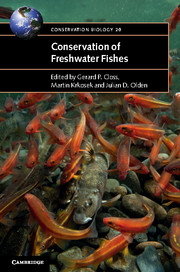Book contents
- Frontmatter
- Contents
- List of contributors
- Preface
- 1 Lost fishes, who is counting? The extent of the threat to freshwater fish biodiversity
- 2 Why are freshwater fish so threatened?
- 3 Climate change effects on freshwater fishes, conservation and management
- 4 Challenges and opportunities for fish conservation in dam-impacted waters
- 5 Chemical pollution
- 6 Multiple stressor effects on freshwater fish: a review and meta-analysis
- 7 Infectious disease and the conservation of freshwater fish
- 8 Non-indigenous fishes and their role in freshwater fish imperilment
- 9 Riparian management and the conservation of stream ecosystems and fishes
- 10 Fragmentation, connectivity and fish species persistence in freshwater ecosystems
- 11 Conservation of migratory fishes in freshwater ecosystems
- 12 Protecting apex predators
- 13 Artificial propagation of freshwater fishes: benefits and risks to recipient ecosystems from stocking, translocation and re-introduction
- 14 Freshwater conservation planning
- 15 Sustainable inland fisheries – perspectives from the recreational, commercial and subsistence sectors from around the globe
- 16 Understanding and conserving genetic diversity in a world dominated by alien introductions and native transfers: the case study of primary and peripheral freshwater fishes in southern Europe
- 17 Maintaining taxonomic skills; the decline of taxonomy – a threat to fish conservation
- 18 Synthesis – what is the future of freshwater fishes?
- Index
- References
10 - Fragmentation, connectivity and fish species persistence in freshwater ecosystems
Published online by Cambridge University Press: 05 December 2015
- Frontmatter
- Contents
- List of contributors
- Preface
- 1 Lost fishes, who is counting? The extent of the threat to freshwater fish biodiversity
- 2 Why are freshwater fish so threatened?
- 3 Climate change effects on freshwater fishes, conservation and management
- 4 Challenges and opportunities for fish conservation in dam-impacted waters
- 5 Chemical pollution
- 6 Multiple stressor effects on freshwater fish: a review and meta-analysis
- 7 Infectious disease and the conservation of freshwater fish
- 8 Non-indigenous fishes and their role in freshwater fish imperilment
- 9 Riparian management and the conservation of stream ecosystems and fishes
- 10 Fragmentation, connectivity and fish species persistence in freshwater ecosystems
- 11 Conservation of migratory fishes in freshwater ecosystems
- 12 Protecting apex predators
- 13 Artificial propagation of freshwater fishes: benefits and risks to recipient ecosystems from stocking, translocation and re-introduction
- 14 Freshwater conservation planning
- 15 Sustainable inland fisheries – perspectives from the recreational, commercial and subsistence sectors from around the globe
- 16 Understanding and conserving genetic diversity in a world dominated by alien introductions and native transfers: the case study of primary and peripheral freshwater fishes in southern Europe
- 17 Maintaining taxonomic skills; the decline of taxonomy – a threat to fish conservation
- 18 Synthesis – what is the future of freshwater fishes?
- Index
- References
Summary
OVERVIEW
Fragmentation poses one of the greatest threats to freshwater fish biodiversity (Nilsson et al., 2005; Reidy-Liermann et al., 2012). Whereas damming of large rivers is perhaps the most obvious form of fragmentation (e.g., Nilsson et al., 2005), smaller, semipermeable barriers such as road crossings (Perkin & Gido, 2012) or water withdrawals that dry sections of a river network (Falke et al., 2011) also pose a conservation challenge. In glacial regions, lakes that are naturally connected through waterways are increasingly being isolated by summer evaporation and groundwater loss (Baki et al., 2012). Climate and land-use changes also isolate populations in headwater reaches by increasing temperatures (Rahel et al., 1996) or drying of streams (Falke et al., 2011) in downstream reaches. Finally, barriers can form when the occurrence of a species, such as a large predator, inhibits the movement of prey through a dispersal corridor (Fraser et al., 1995). This severing of connectivity in aquatic habitats affects species persistence through multiple stressors (Chapters 4 and 6) including limiting dispersal necessary to fulfil important life stages, exacerbating negative species interactions, and inhibiting recolonisation following disturbance. Barriers to movement isolate small populations leading to reduced genetic diversity (Chapter 16) and potentially compromise long-term population persistence (e.g. Wofford et al., 2005).
In this chapter, we discuss how fragmentation disrupts dispersal and migration of freshwater fishes and the long-term consequences for population diversity and stability. We begin with a global overview of the problem followed by a review of theoretical and empirical methods for quantifying the effects of fragmentation on population viability. We conclude with a discussion of conservation challenges along with future research and management recommendations. The primary tenet of our review is that persistence of species in fragmented systems is dependent on the nature of barriers to dispersal and ecological traits of species, particularly their ability to complete critical life-history stages within fragmented habitats (Figure 10.1). We often refer to the terms fragmentation, isolation and connectivity. Whereas there are instances where these might be used interchangeably, we consider fragmentation to represent habitats that have been partitioned into smaller habitats and by extension result in smaller populations. The terms connectivity and isolation refer to the ability or lack of ability, respectively, of fishes to disperse into or out of particular habitats.
- Type
- Chapter
- Information
- Conservation of Freshwater Fishes , pp. 292 - 323Publisher: Cambridge University PressPrint publication year: 2015
References
- 41
- Cited by



